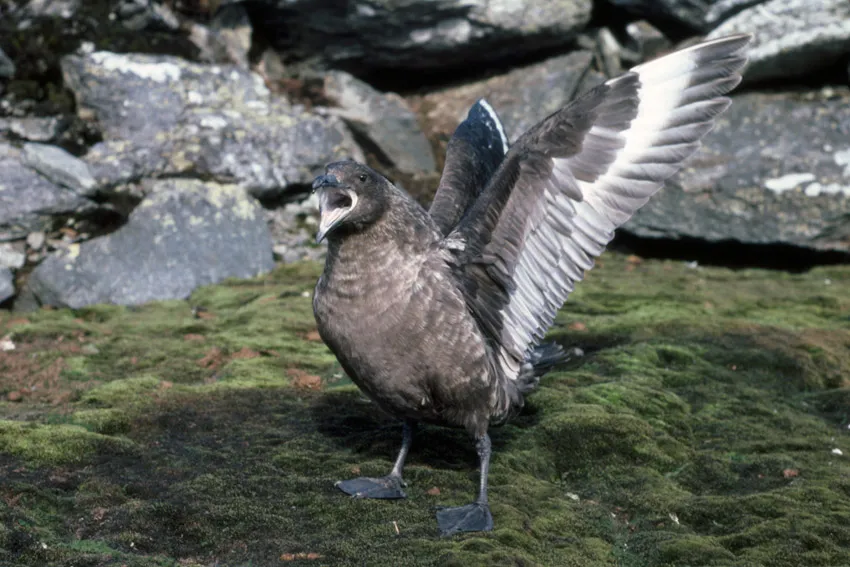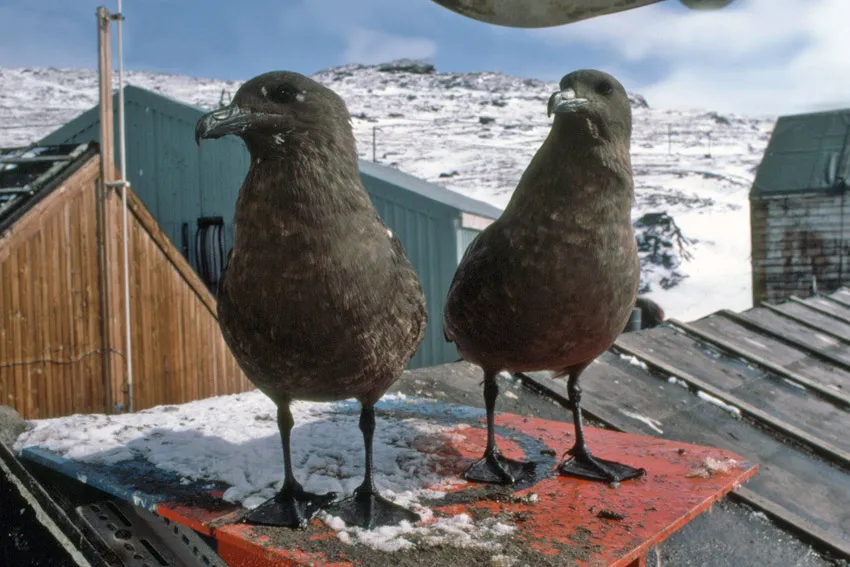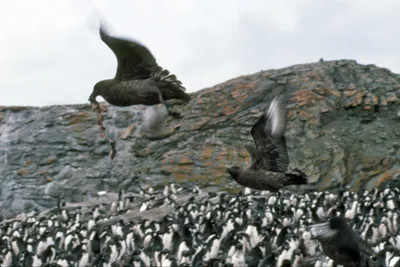Antarctic or South Polar Skuas
Catharacta maccormicki
South Polar skua facts Basics
Average Weight: 900 - 1600 g, males
are usually a little smaller and lighter than females
Average Length: 50 - 55 cm, wingspan 130 -
140 cm
Breeding Season: Breeds in
snow free areas from November to January. Incubation 24-34
days, chicks fledge at 35 to 45 days old. There are usually
two eggs though it is rare that both survive to fledge.
The chick leaves the nest 1 to 2 days after hatching and
is quite mobile within a territorial area where it continues
to be attended by its parents.
Estimated
world population: - 39,000 to 42,000.
Feeding & diet: The mainstay of skuas diet
is fish and krill, though penguins, as eggs, chicks and
carrion form a variable but sometimes exclusive supplement
depending on location. Fish may be obtained by stealing
it from other birds, particularly gulls.
Conservation status: Least concern.
Distribution: Widespread throughout coastal
regions in Antarctica, migrates across the equator in the
Antarctic winter reaching as far as Alaska and Greenland.
Skuas have been seen at the south pole.
What are Skuas like?
The South Polar Skua (Catharacta maccormicki) is the size of a largish gull. They nest all around continental Antarctica and breed into the deep south. They are excellent fliers and have occasionally been sighted deep in the interior hundreds of miles from anything other than ice, even as far south as the pole. One of their feeding techniques is to chase and bully other birds into regurgitating the contents of their crop, a strategy successful with some species that are in themselves excellent fliers.Skuas tend to have a reputation as being fierce and aggressive birds, which is somewhat unfair. I see them more as characters who stick up for their own corner and look after their own - no more or less than humans do.
Often a visitors first sight of a skua is at a penguin colony where they usually are nesting nearby. They hang around as a dark presence looking for unguarded eggs or weak or isolated chicks to prey on, which is a very productive means of finding food, but does their reputation no good at all.
Displaying Skuas
Skuas display to, or for a mate or to other skuas to establish their territory. Sometimes the birds can be seen to do this as a pair, it is quite an impressive sight and the squawking can be heard some considerable distance away. Skuas will also do this if their nest is being approached by an unwanted visitor. It is a generic "Look at me, I am here" statement.
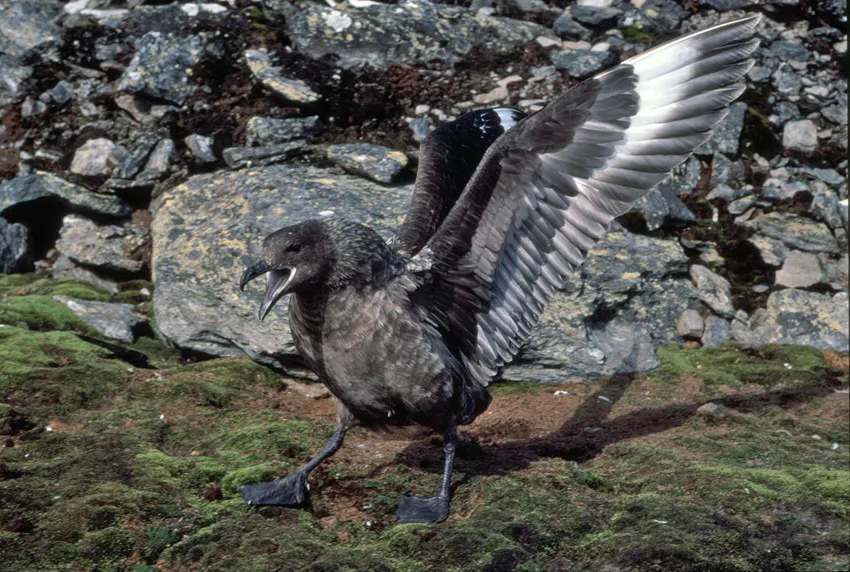
The guy with the treats
has come to see you, at the very least you'll get your portrait
taken.
More often though the first sign that a visitor gets of being near to a skuas nest or chick is of a sudden heart-stopping sound just behind your head caused by the rush of air through the wing feathers of the parent bird flying at speed past your head from behind, much too close for comfort. If you're particularly unlucky or if its very unhappy at you being so close, then rarely a whack at the back of the head by the front of the wing may result. Some people can get quite fazed by these unexpected "attacks", I found the best way to deal with them was to raise one arm straight up into the air when you hear the skua behind you which would cause it to pull up to avoid your arm. It makes you look a bit odd walking through Antarctica occasionally giving a black power salute, but works for human and skua alike. When the skuas start to do this, it is usually an indication you are close to their chick which can be excellently camouflaged against the ground, so it's time to take a look around and if you see the chick, walk in the opposite direction which causes the parents to leave you alone.
This bird (left picture) however was used to people and was calling to his mate to come quick as there may be some give-away food. The biggest problem I had taking this shot was getting the bird far enough away as he kept sticking his beak just a few cm from my lens, checking it out for edibility.
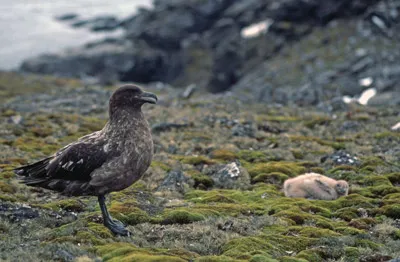
Adult skua with chick
off the nest trying to blend in and be invisible, in this case
the adult almost trusts me and isn't panicking, but this is
not normal, don't try this at home.
Friendly Skuas
These birds are on the specially made skua landing platform (also used by occasional Dominican gulls and sheathbills) outside the kitchen window of the scientific station on Signy island in the South Orkneys.
There were two pairs of skuas that used it regularly (never at the same time though), the "Reds" and the "Blues" they lived respectively to the sides of the platform of their colours. This is Mr. and Mrs. Blue. Their nest was about 250m away downhill of this rooftop platform (to the left) and occasionally when feeling lazy, they would walk up the hill rather than fly apart from the last bit onto the roof, and then glide downhill back home.
Sometimes If I was out nearby they would come to see if they could get any free food, squawking and hovering above me (the more nervous would interpret this as an "attack"). If I lent over forwards, then sometimes one would land on my shoulders and look quizzically sideways at me as if to say "Now what?". I also had one of them once try to land on a back-pack I was carrying as I was walking along. Unfortunately it was a purpose made back pack for carrying trash that consisted of a frame with two large open top cans attached (it was empty at the time). The first I knew what was happening was when Mrs. Blue fell into one and with much scrabbling and panic managed to get out of it before settling nearby and giving me a haughty stare.
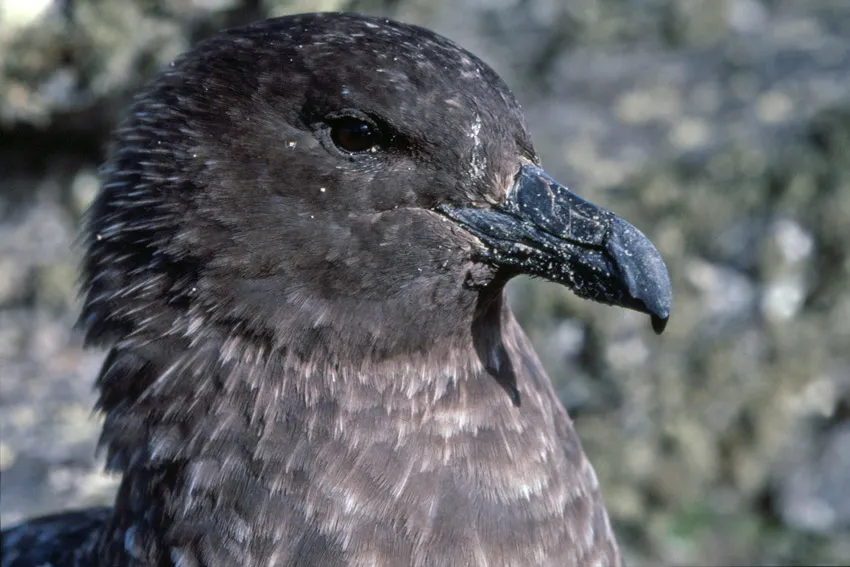
Mr. Blue come to have
his portarit taken and show what a handsome fellow he is.
To skua - verb
Skua - to appropriate goods by means that are not quite stealing, but also not quite not-stealing. Named after Antarctic Skuas that hang out near the Galley in McMurdo. - American, South Pole and McMurdo stations

